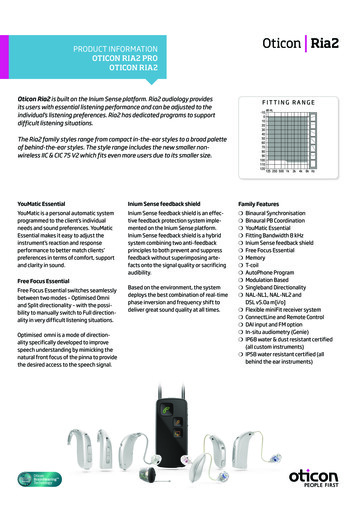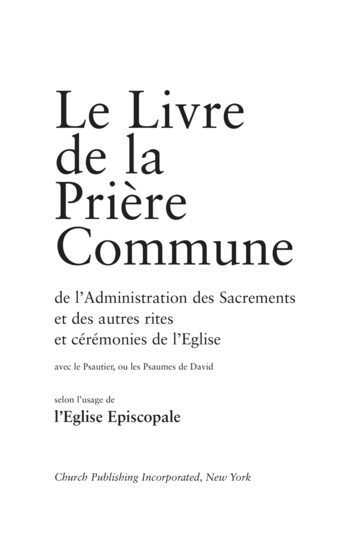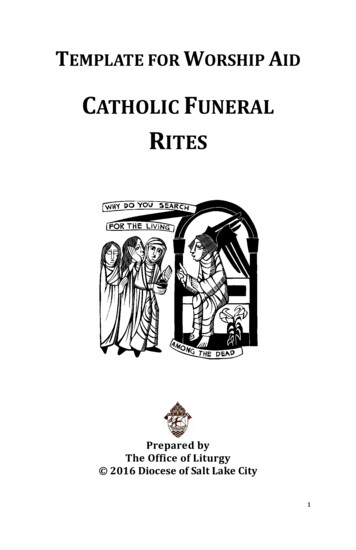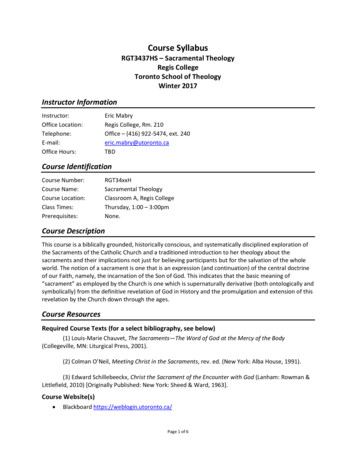
Transcription
Approved Sacramental GuidelinesThe Rite of Christian Initiation of MarriageHoly Orders
Guidelinesfor thePreparation and Celebrationof theSacraments of Initiationfor theDiocese of Fort Worth
The Rite of Christian Initiation of AdultsTable of ContentsDOCTRINAL OVERVIEW1HISTORICAL SUMMARY OF THE SACRAMENTS OF INITIATION . 1THEOLOGY OF THE SACRAMENTS OF INITIATION, CORRELATION WITH THE CATECHISM OF THECATHOLIC CHURCH AND THE RITE FOR CHRISTIAN INITIATION OF ADULTS, AND IMPLICATIONS FORPREPARATION FOR FULL INITIATION INTO THE CATHOLIC CHURCH. 3PASTORAL AND CATECHETICAL PRINCIPLES13GENERAL PASTORAL AND CATECHETICAL PRINCIPLES . 13PRINCIPLES FOR THE PREPARATION AND CELEBRATION OF THE SACRAMENTS OF INITIATION INTHE RITE OF CHRISTIAN INITIATION OF ADULTS (RCIA). 13POLICIES15THE PERSON TO BE INITIATED . 15THE PARISH . 16NORMS FOR READINESS19THE RITE OF CHRISTIAN INITIATION OF ADULTS20GENERAL LITURGICAL PRINCIPLES . 20LITURGICAL PRINCIPLES FOR CELEBRATING THE RITE OF CHRISTIAN INITIATION OF ADULTS . 20THE RITE OF ACCEPTANCE/WELCOME . 21RITES ASSOCIATED WITH THE PERIOD OF CATECHUMENATE AND CATECHETICAL FORMATION . 21ELECTION AND CALL TO CONTINUING CONVERSION . 22RITES ASSOCIATED WITH THE PERIOD OF PURIFICATION AND ENLIGHTENMENT ANDPREPARATION FOR THE EASTER SACRAMENTS . 23CELEBRATION OF THE SACRAMENTS OF INITIATION . 23RITES ASSOCIATED WITH THE PERIOD OF MYSTAGOGY . 24GLOSSARY25
GUIDELINES FOR THE PREPARATION AND CELEBRATION OF THE RITE OFCHRISTIAN INITIATION OF ADULTS (WITH ADAPTATIONS FOR CHILDREN OFCATECHETICAL AGE); WITH GLOSSARYI.Doctrinal OverviewN.B. Because the Rite of Christian Initiation of Adults is oriented primarily to the initiationof those who are unbaptized, this doctrinal overview focuses upon the catechumenate.A. HISTORICAL SUMMARY OF THE SACRAMENTS OF INITIATION1. Summarya. The Church’s initiation procedure was loosely organized, much like the rites of earlyJewish sects.b. It included a period of preparation for instruction and repentance, then reception intothe community through a bath of water and sometimes a laying on of hands.2. Second Century through Fifth Centurya. Candidates for Baptism have a long period of preparation including instruction,prayer, and doing good works.b. When ready for Baptism, candidates were vouched for by their sponsor, and bathed,fasted, and prayed before receiving the sacrament.c. For the ceremony the candidates were exorcised and anointed. After disrobing, theywent into the water to profess their faith and be baptized.d. Clothed in white garments, they received a final anointing by the bishop to confirmtheir new life in Christ.e. When bishops found it impossible to attend all baptisms, the Western Churchseparated this final anointing from the baptism itself to be administered later in theceremony of Confirmation by the bishop.3. Sixth Century to Twentieth Centurya. In the Middle Ages, Christianity became the common belief, and infant Baptisms, thegeneral rule.b. The long preparation for Baptism was no longer needed.c. In some areas, the child was confirmed at the time of Baptism, but as time went on,this ceremony was postponed until a later age.RCIA1
d. The Council of Trent in 1565 stated the “age of reason” as right for Confirmatione. Confirmation was no longer seen as simply a sealing of Baptism but rather as asacrament of growth, confirming the Christian person’s faith.f. The Bishop’s Kiss of Peace became a blow on the cheek to signify that one must beready to suffer for Christ.Adapted from The Changing Sacraments. Reprinted by permission of St. Anthony Messenger Press, 1615 Republic Street,Cincinnati, Ohio 45210. All rights reserved4. Vatican II to the presenta. The first document of Vatican II, the Constitution on the Sacred Liturgy (1963),mandated restoration of the ancient order of initiation of adults known as thecatechumenate:The catechumenate for adults, comprising several distinct steps, is to be restoredand to be brought into use at the discretion of the local ordinary. By this meansthe time of the catechumenate, which is intended as a period of suitableinstruction, may be sanctified by sacred rites to be celebrated at successiveintervals of time. (Sacrosanctum Concilium, 64)b. In 1972, the Rite of Christian Initiation of Adults (RCIA), as mandated by Vatican II,was published. A provisional English version of the text was made available in 1974.c. For the next ten years, parishes in the United States (and the Diocese of Fort Worth)began implementing the catechumenal process of initiation.d. In 1983, several minor changes were made in the RCIA to bring it into conformitywith the new Code of Canon Law.e. National statutes for the catechumenate for the United States were approved by theNational Conference of Catholic Bishops in 1986 and confirmed by the Holy See in1987. The final English version of the ritual text was published and itsimplementation mandated in 1988.f. The Christian initiation of adults includes not only a period of well-suited instructionand a time sanctified by liturgical rites to be celebrated at successive intervals, butalso a gradual integration into the full, conscious and active life of the Catholiccommunity.g. While current practice, both worldwide and locally, remains varied, the trend ismoving away from a school year model of implementation to an approach that ismore flexible. Such flexibility is better suited to the individual needs of thoseseeking full communion with the Church and to the process of conversion which iscontinually turning one’s life toward the Gospel.RCIA2
B. THEOLOGY OF THE SACRAMENTS OF INITIATION, CORRELATION WITHTHE CATECHISM OF THE CATHOLIC CHURCH AND THE RITE FOR CHRISTIANINITIATION OF ADULTS, AND IMPLICATIONS FOR PREPARATION FOR FULLINITIATION INTO THE CATHOLIC CHURCH.1. Participation in the Paschal Mystery through membership in the Church is a giftGod gives through preparation for and celebration of the sacraments of initiation:Baptism, Confirmation, and Eucharist. Baptism brings forgiveness of all sin and the beginning of new life in Christ. Confirmation strengthens and seals the baptismal mission of the faithful. Eucharist, sacrifice and meal, nourishes the faithful with Christ’s Body and Blood.Correlation with The Catechism of the Catholic Church (CCC) and The Rite ofChristian Initiation of Adults (RCIA)CCC 1229: From the time of the apostles, becoming a Christian has beenaccomplished by a journey and initiation in several stages. This journey can becovered rapidly or slowly, but certain essential elements will always have to bepresent: proclamation of the Word, acceptance of the Gospel entailingconversion, profession of faith, Baptism itself, the outpouring of the Holy Spirit,and admission to Eucharistic communion.RCIA, Christian Initiation, General Introduction 1: In the sacraments ofChristian initiation we are freed from the power of darkness and joined toChrist’s death, burial, and resurrection. We receive the Spirit of filial adoptionand are part of the entire people of God in the celebration of the memorial of theLord’s death and resurrection.CCC 1263: By Baptism all sins are forgiven, original sin and all personal sins, aswell as all punishment for sin. In those who have been reborn nothing remainsthat would impede their entry into the Kingdom of God, neither Adam’s sin, norpersonal sin, nor the consequences of sin, the gravest of which is separation fromGod.RCIA, General Introduction 2a: Baptism incorporates us into Christ and formsus into God’s people. This first sacrament pardons all our sins, rescues us fromthe power of darkness, and brings us to the dignity of adopted children, a newcreation through water and the Holy Spirit. Hence we are called and are indeedthe children of God.CCC 1296: Christ himself declared that he was marked with his Father’s seal.Christians are also marked with a seal: “It is God who establishes us with you inChrist and has commissioned us; he has put his seal on us and given us his Spiritin our hearts as a guarantee.” This seal of the Holy Spirit marks our totalRCIA3
belonging to Christ, our enrollment in his service for ever, as well as the promiseof divine protection in the great eschatological trial.RCIA, General Introduction 2b: By signing us with the gift of the Spirit,confirmation makes us more completely the image of the Lord and fills us with theHoly Spirit, so that we may bear witness to him before all the world and work tobring the Body of Christ to its fullness as soon as possible.RCIA 215: In accord with the ancient practice followed in the Roman Liturgyadults are not to be baptized without receiving confirmation immediatelyafterward, unless some serious reason stands in the way. The conjunction of thetwo sacraments signifies the unity of the paschal mystery, the close link betweenthe mission of the Son and the outpouring of the Holy Spirit, and the connectionbetween the two sacraments through which the Son and the Holy Spirit come withthe Father to those who are baptized.CCC 1322: The holy Eucharist completes Christian initiation. Those who havebeen raised to the dignity of the royal priesthood by Baptism and configured moredeeply to Christ by Confirmation participate with the whole community in theLord’s own sacrifice by means of the Eucharist.RCIA, General Introduction 2c: Finally, coming to the table of the eucharist, weeat the flesh and drink the blood of the Son of Man so that we may have eternallife and show forth the unity of God’s people. By offering ourselves with Christ weshare in the universal sacrifice, that is, the entire community of the redeemedoffered to God by their High Priest, and we pray for a greater outpouring of theHoly Spirit, so that the whole human race may be brought into the unity of God’sfamily.Implications:Christ’s Paschal Mystery, his death, resurrection, ascension, and the sending ofthe Holy Spirit, is the foundation of the Church and the Church’s sacraments.Baptism, Confirmation, and Eucharist initiate one into this Mystery. RCIA teamshelp those to be initiated to recognize how the Holy Spirit reveals the dying andrising pattern of the Paschal Mystery in their lives. Though human expertise,planning, and work are needed for the preparation of these sacraments, thesacraments themselves are a gift from God and not from human initiative.Therefore the process of initiation is not governed by human conventions such asan academic year or membership in a particular year’s class.Correlation with The Catechism of the Catholic Church (CCC) and The Rite ofChristian Initiation of Adults (RCIA)CCC 1212: The sacraments of Christian initiation – Baptism, Confirmation, andEucharist – lay the foundation of every Christian life.RCIA4
2. Together forming the core of the Rite of Christian Initiation of Adults (RCIA), thesethree sacraments are the foundation of Christian life, both for individuals seekingconversion to Christ in the Church, and for the Church herself.RCIA, General Instruction, 2d: Thus the three sacraments of Christian initiationclosely combine to bring us, the faithful of Christ, to his full stature and to enableus to carry out the mission of the entire people of God in the Church and in theworld.Implications: All activities related to catechumenate should be inspired by the ritual text. While retaining their distinct characteristics and proper ends, the sacramentsof initiation form a unity and are combined in one liturgical celebration. Those responsible for preparation of catechumens and candidates for fullcommunion and for the corresponding liturgical celebrations shouldthemselves be thoroughly familiar with the Rite of Christian Initiation ofAdults and adequately prepared for whatever ministries they undertake. In order to acknowledge and honor the valid baptism of those seeking fullcommunion with the Church, care must be taken to maintain all legitimatedistinctions between catechumens (unbaptized) and candidates (baptizedChristian but uncatechized in the Catholic faith).3. The goal of Christian initiation is conversion to Christ in a life of discipleship.Correlation with The Catechism of the Catholic Church (CCC) and The Rite ofChristian Initiation of Adults (RCIA)CCC 1692: The Symbol of the faith confesses the greatness of God’s gifts to manin his work of creation, and even more in redemption and sanctification. Whatfaith confesses, the sacraments communicate: by the sacraments of rebirth,Christians have become “children of God,” [Jn 1:12 ; 1Jn 3:1 .] “partakers ofthe divine nature” [2Pet 1:4.] Coming to see in the faith their new dignity,Christians are called to lead henceforth a life “worthy of the gospel of Christ.”[Phil 1:27 .] They are made capable of doing so by the grace of Christ and thegifts of his Spirit, which they receive through the sacraments and through prayer.RCIA 1: The rite of Christian initiation presented here is designed for adultswho, after having the mystery of Christ proclaimed, consciously and freely seekthe living God and enter the way of faith and conversion as the Holy Spirit openstheir hearts. By God’s help they will be strengthened spiritually during theirpreparation and at the proper time will receive the sacraments fruitfully.Implications: Catechumens and candidates need to be taught explicitly that the goal of theprocess is not membership in a merely human institution, but a new way ofliving in Christ, expressed through active participation in the mission of theChurch, in which the Spirit of God resides.RCIA5
The challenges and blessings of discipleship as a way of life should be madeclear throughout the entire process.4. Conversion to Christ is a journey, marked by a series of initiatory stages andaffirmed by ritual celebrations, as quoted below (Part 1, Rite of Christian Initiationof Adults; no paragraph number given, see p. 14)PERIOD OF EVANGELIZATION AND PRECATECHUMENATEThis is a time, of no fixed duration or structure, for inquiry and introduction to Gospelvalues, an opportunity for the beginnings of faith.First Step: Acceptance into the Order of CatechumensThis is the liturgical rite, usually celebrated on some annual date or dates, marking thebeginning of the catechumenate proper, as the candidates express and the Churchaccepts their intention to respond to God’s call to follow the way of Christ.PERIOD OF THE CATECHUMENATEThis is the time, in duration corresponding to the progress of the individual, for thenurturing and growth of the catechumens’ faith and conversion to God; celebrations ofthe word and prayers of exorcism and blessing are meant to assist the process.Second Step: Election or Enrollment of NamesThis is the liturgical rite, usually celebrated on the First Sunday of Lent, by which theChurch formally ratifies the catechumens’ readiness for the sacraments of initiation andthe catechumens, now the elect, express the will to receive these sacraments.PERIOD OF PURIFICATION AND ENLIGHTENMENTThis is the time immediately preceding the elects’ initiation, usually the Lenten seasonpreceding the celebration of this initiation at the Easter Vigil; it is a time of reflection,intensely centered on conversion, marked by celebration of the scrutinies andpresentations and of the preparation rites on Holy Saturday.Third Step: Celebration of the Sacraments of InitiationThis is the liturgical rite, usually integrated into the Easter Vigil, by which the elect areinitiated through baptism, confirmation, and the eucharist.PERIOD OF POSTBAPTISMAL CATECHESIS OR MYSTAGOGYThis is the time, usually the Easter season, following the celebration of initiation, duringwhich the newly initiated experience being fully a part of the Christian community bymeans of pertinent catechesis and particularly by participation with all the faithful in theSunday eucharistic celebration.Correlation with The Catechism of the Catholic Church (CCC) and The Rite ofChristian Initiation of Adults (RCIA)CCC 1229: From the time of the apostles, becoming a Christian has beenaccomplished by a journey and initiation in several stages. This journey can beRCIA6
covered rapidly or slowly, but certain essential elements will always have to bepresent: proclamation of the Word, acceptance of the Gospel entailingconversion, profession of faith, Baptism itself, the outpouring of the Holy Spirit,and admission to Eucharistic communion.RCIA 2: This rite includes not simply the celebration of the sacraments ofbaptism, confirmation, and eucharist, but also all the rites belonging to thecatechumenate.RCIA 5: The rite of initiation is suited to a spiritual journey of adults that variesaccording to the many forms of God’s grace, the free cooperation of theindividuals, the action of the Church, and the circumstances of time and place.Implications: Dialogue with the biblical stories of journey and the lived tradition of theChurch is a primary source for the process of initiation. Each one of the periods and rituals is integral to the process of initiation ofcatechumens and deserves careful attention. Since the RCIA is the norm for all initiation, the journey of baptizedcandidates—even those whose preparation requires less time—also followsthe pattern of initiatory stages and ritual celebrations. In the initiation process, the role of the bishop as pastor of the local Church isalways honored.5. Preparation for the new life of discipleship, because it involves the whole person, hasthe character of an apprenticeship in Christian life. It requires a balance ofdoctrinal, liturgical and spiritual formation, in the context of a community of faith,flowing from the proclamation of the Word of God. Nurturing an initial call to faith and repentance Discerning God’s presence through reflection on daily life in light of Scripture andprayer Fostering inclusion in the community of faith Developing the habit and practice of prayer and regular reading of Scripture. Encouraging a life of active witness through justice and charityCorrelation with The Catechism of the Catholic Church (CCC) and The Rite ofChristian Initiation of Adults (RCIA)CCC 1248: The catechumenate, or formation of catechumens, aims at bringingtheir conversion and faith to maturity, in response to the divine initiative and inunion with an ecclesial community. The catechumenate is to be “a formation inthe whole Christian life . . . during which the disciples will be joined to Christtheir teacher. The catechumens should be properly initiated into the mystery ofsalvation and the practice of the evangelical virtues, and they should beintroduced into the life of faith, liturgy, and charity of the People of God byRCIA7
successive sacred rites.” [AG 14; cf. RCIA 19; 98.]RCIA 75: The catechumenate is an extended period during which the candidatesare given suitable pastoral formation and guidance, aimed at training them in theChristian life. In this way the dispositions manifested at their acceptance into thecatechumenate are brought to maturity.CCC 1431: Interior repentance is a radical reorientation of our whole life, areturn, a conversion to God with all our heart, an end of sin, a turning away fromevil, with repugnance toward the evil actions we have committed. At the sametime it entails the desire and resolution to change one’s life, with hope in God’smercy and trust in the help of his grace. This conversion of heart is accompaniedby a salutary pain and sadness which the Fathers called animi cruciatus(affliction of spirit) and compunctio cordis (repentance of heart). [Cf. Council OfTrent (1551) DS 1676-1678; 1705; Cf. Roman Catechism, II, V, 4.] “RCIA 37: From evangelization, completed with the help of God, come the faithand initial conversion that cause a person to feel called away from sin and drawninto the mystery of God’s love. . . .CCC 2688: The catechesis of children, young people, and adults aims at teachingthem to meditate on The Word of God in personal prayer, practicing it inliturgical prayer, and internalizing it at all times in order to bear fruit in a newlife. Catechesis is also a time for the discernment and education of popularpiety.[Cf. CT 54.] The memorization of basic prayers offers an essential supportto the life of prayer, but it is important to help learners savor their meaning.RCIA 75, 2: As they become familiar with the Christian way of life and arehelped by the example and support of sponsors, godparents, and the entireChristian community, the catechumens learn to turn more readily to God inprayer, to bear witness to the faith, in all things to set their hopes on Christ, tofollow supernatural inspiration in their deeds, and to practice love of neighbor,even at the cost of self renunciation. . . . .CCC 6: While not being formally identified with them, catechesis is built on acertain number of elements of the Church’s pastoral mission which have acatechetical aspect, that prepare for catechesis, or spring from it. They are: theinitial proclamation of the Gospel or missionary preaching to arouse faith;examination of the reasons for belief; experience of Christian living; celebrationof the sacraments; integration into the ecclesial community; and apostolic andmissionary witness. [CT 18.]RCIA 9,1: . . . the faithful should . . . show themselves ready to give thecandidates evidence of the spirit of the Christian community and to welcome theminto their homes, into personal conversion, and into community gatherings.RCIA8
CCC 2662: The Word of God, the liturgy of the Church, and the virtues of faith,hope, and charity are sources of prayer.CCC 2720: The Church invites the faithful to regular prayer: daily prayers, theLiturgy of the Hours, Sunday Eucharist, the feasts of the liturgical year.CCC 2725: Prayer is both a gift of grace and a determined response on our part.It always presupposes effort. . . .RCIA 142: Because they are asking for the three sacraments of initiation, theelect must have the intention of achieving an intimate knowledge of Christ and hisChurch, and they are expected particularly to progress in genuine self-knowledgethrough serious examination of their lives and true repentance.CCC 1072: “The sacred liturgy does not exhaust the entire activity of theChurch”: [SC 9.] it must be preceded by evangelization, faith, and conversion. Itcan then produce its fruits in the lives of the faithful: new life in the Spirit,involvement in the mission of the Church, and service to her unity.RCIA 75, 4: Since the Church’s life is apostolic, catechumens should also learnhow to work actively with others to spread the Gospel and build up the Church bythe witness of their lives and by professing their faith.Implications: In the process of preparing people for the sacraments of initiation, Scripture isprimary. Care must be taken to devise a program of preparation and celebration whichaddresses the personal experience of participants. Sufficient formation will require significant time. The example of team members, sponsors, and parishioners will be crucial inincorporating new people into the life of the Church. Clear and frequent communication regarding opportunities for participation inparish events will be important for those seeking initiation. Information concerning resources for assisting those with special needs (e.g.,marriage cases, moral dilemmas, counseling) should be available from thevery beginning of the Inquiry process.6. After experiencing the Paschal Mystery through the sacramental celebration ofinitiation, both the newly initiated and the rest of the faithful are enriched throughpost initiation catechesis, also known as mystagogy. Clarifying understanding of faith Deepening a sense of belonging Strengthening commitment to discipleshipRCIA9
Correlation with The Catechism of the Catholic Church (CCC) and The Rite ofChristian Initiation of Adults (RCIA)CCC 1212: The sacraments of Christian initiation – Baptism, Confirmation, andEucharist – lay the foundations of every Christian life.RCIA 9, 5: During the period immediately after baptism, the faithful should takepart in the Masses for neophytes, that is, the Sunday Masses of the Easter season(see no. 25), to welcome the neophytes with open arms in charity, and to helpthem feel more at home in the community of the baptized.CCC 1234: By following the gestures and words of this celebration with attentiveparticipation, the faithful are initiated into the riches this sacrament signifies andactually brings about in each newly baptized person.RCIA 244: . . . mystagogy. . . . is a time for the community and the neophytestogether to grow in deepening their grasp of the paschal mystery and in making itpart of their lives through meditation on the Gospel . . .RCIA 245: The neophytes are, as the term “mystagogy” suggests, introduced intoa fuller and more effective understanding of mysteries through the Gospelmessage they have learned and above all through the experience of thesacraments they have received.CCC 6: . . . catechesis is built on a certain number of elements of the Church’spastoral mission . . . [including] integration into the ecclesial community.RCIA 9, 5: During the period immediately after baptism, the faithful should . . .help them feel more at home in the community of the baptized.CCC 6: catechesis is built on a certain number of elements of the Church’spastoral mission . . . [including] apostolic and missionary witness.[CT 18.]CCC 1698: The first and last point of reference of this catechesis will always beJesus Christ himself, who is “the way, and the truth, and the life.” [Jn 14:6 .] It isby looking to him in faith that Christ’s faithful can hope that he himself fulfills hispromises in them, and that, by loving him with the same love with which he hasloved them, they may perform works in keeping with their dignity . . .RCIA 7, 4: The final period extends through the whole Easter Season and isdevoted to the postbaptismal catechesis or mystagogy. It is a time for deepeningthe Christian experience, for spiritual growth, and for entering more fully into thelife and unity of the community.RCIA10
RCIA 245: . . . Out of this experience [i.e., everything surrounding mystagogy],which belongs to Christians and increases as it is lived, they derive a newperception of the faith, of the Church, and of the world.Implications: Intentional, extended, post-initiation catechesis is a necessary element of theRite. A prime catechetical goal of this period is helping the neophytes and the entirecommunity to explore and understand the meaning of the sacramentscelebrated at the Vigil, through reflection upon the seasonal lectionaryreadings. Catechesis on the sacraments and liturgy during the period of mystagogymakes the connection between liturgy and daily life and leads to deepermaturity in faith. The whole catechumenal process makes clear the developmental character ofChristian life which is ongoing after the Easter Vigil. Life in Christ has thenature of a journey and therefore needs continued spiritual guidance.7. The RCIA takes place in a parish which takes seriously its mission to evangelize.The parish proclaims the Good News of God’s love through word and deed in a waywhich invites and nourishes a response of faith. Celebration of RCIA and the parish mission to evangelize are always intertwined. Responsibility for the Christian initiation of adults lies with the entire parishcommunity, as active participants in its ritual elements and in the many ministries itrequires. The continual preparation for and celebration of the RCIA is central to the ongoingconversion and discipleship of the local community.Correlation with The Catechism of the Catholic Church (CCC) and The Rite ofChristian Initiation of Adults (RCIA)CCC 2179: . . . The parish initiates the Christian people into the ordinaryexpression of the liturgical life: it gathers them together in this celebration; itteaches Christ’s saving doctrine; it practices the charity of the Lord in goodworks and brotherly love . . .CCC 1428: Christ’s call to conversion continues to resound in the lives ofChristians. This second conversion is an uninterrupted task for the whole Churchwho, “clasping sinners to her bosom, [is] at once holy and always in need ofpurification, [and] follows constantly the path of penance and renewal.” [LG 8 #3.] This endeavor of conversion is not just a human work. It is the movement of a“contrite heart,” drawn and moved by grace to respond to the merciful love ofGod who loved us first. [Ps 51:17 ; cf. Jn 6:44 ; Jn 12:32 ; 1Jn 4:10 .]”RCIA 9: In light of what is said in Christian Initiation, General Instruction (no.7), the people of God, as represented by the local Church, should understand andRCIA11
show by their concern that the initiation of adults is the responsibility of all thebaptized. Therefore the community must always be fully prepared in the pursuitof its apostolic vocation to give help to those who are searching for Christ. I
present: proclamation of the Word, acceptance of the Gospel entailing conversion, profession of faith, Baptism itself, the outpouring of the Holy Spirit, and admission to Eucharistic communion. RCIA, Christian Initiation, General Introduction 1: In the sacraments of Christian initiation we are freed from the power of darkness and joined to










